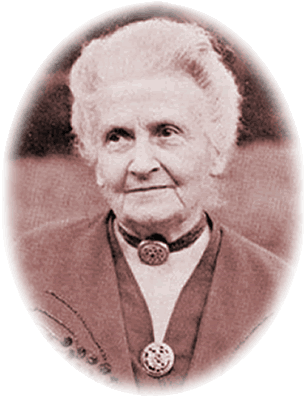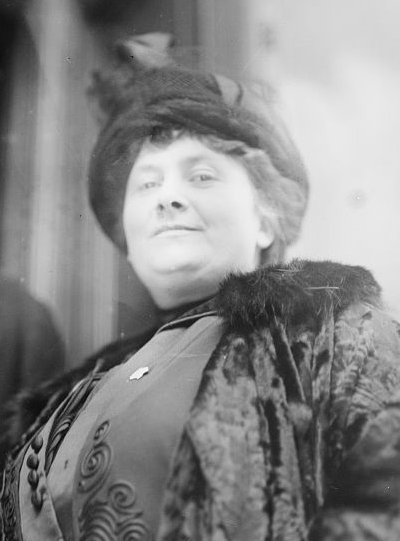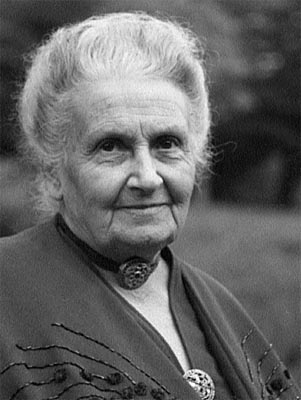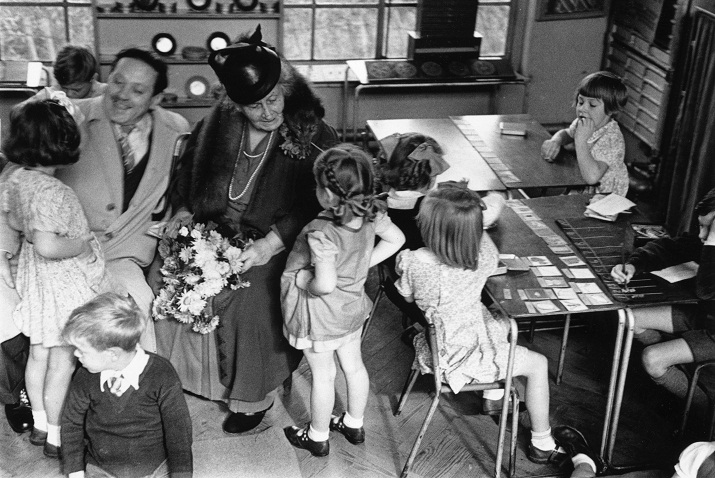<Back to Index>
- Educator Maria Montessori, 1870
- Composer Alma Maria Mahler Gropius Werfel, 1879
- Chancellor of the German Empire Georg Friedrich Graf von Hertling, 1843
PAGE SPONSOR



Maria Montessori (August 31, 1870 – May 6, 1952) was an Italian physician and educator, a noted humanitarian and devout Catholic best known for the philosophy of education which bears her name. Her educational method is in use today in public as well as private schools throughout the world.
Maria Montessori was born in 1870 in Chiaravalle (Ancona), Italy, to Alessandro Montessori and Renilde Stoppani (niece of Antonio Stoppani). At the age of thirteen she attended an all-boy technical school in preparation for her dream of becoming an engineer. Montessori was the first woman to graduate from the University of Rome La Sapienza Medical School, becoming the first female doctor in Italy. She was a member of the University's Psychiatric Clinic and became intrigued with trying to educate the "special needs" or "unhappy little ones" and the "uneducatable" in Rome. In 1896, she gave a lecture at the Educational Congress in Torino about the training of the disabled. The Italian Minister of Education was in attendance, and, sufficiently impressed by her arguments, appointed her the same year as director of the Scuola Ortofrenica, an institution devoted to the care and education of the mentally retarded. She accepted, in order to put her theories to proof. Her first notable success was to have several of her 8 year old students apply to take the State examinations for reading and writing. The "defective" children not only passed, but had above - average scores, an achievement described as "the first Montessori miracle." Montessori's response to their success was "if mentally disabled children could be brought to the level of normal children then (she) wanted to study the potential of 'normal' children".
"Scientific observation has established that education is not what the teacher gives; education is a natural process spontaneously carried out by the human individual, and is acquired not by listening to words but by experiences upon the environment. The task of the teacher becomes that of preparing a series of motives of cultural activity, spread over a specially prepared environment, and then refraining from obtrusive interference. Human teachers can only help the great work that is being done, as servants help the master. Doing so, they will be witnesses to the unfolding of the human soul and to the rising of a New Man who will not be a victim of events, but will have the clarity of vision to direct and shape the future of human society".
Because of her success with these children, she was asked to start a school for children in a housing project in Rome, which opened on January 6, 1907, and which she called "Casa dei Bambini" or Children's House. Children's House was a child care center in an apartment building in the poor neighborhood of Rome. She was focused on teaching the students ways to develop their own skills at a pace they set, which was a principle Montessori called "spontaneous self-development". A wide variety of special equipment of increasing complexity is used to help direct the interests of the child and hasten development. When a child is ready to learn new and more difficult tasks, the teacher guides the child's first endeavors in order to avoid wasted effort and the learning of wrong habits; otherwise the child learns alone. It has been reported that the Montessori method of teaching has enabled children to learn to read and write much more quickly and with greater facility than has otherwise been possible. The Montessori Method of teaching concentrates on quality rather than quantity. The success of this school sparked the opening of many more, and a worldwide interest in Montessori's methods of education.
After the 1907 establishment of Montessori's first school in Rome, by 1917 there was an intense interest in her method in North America, which later waned, in large part due to the publication of a small booklet entitled "The Montessori System Examined" by William Heard Kilpatrick - a follower of John Dewey. (Nancy McCormick Rambusch contributed to the revival of the method in America by establishing the American Montessori Society in 1960); at the same time Margaret Stephenson came to the US from Europe and began a long history of training Montessori teachers under the auspices of the Association Montessori Internationale (AMI). Montessori was exiled by Mussolini mostly because she refused to compromise her principles and make the children into soldiers. She moved to Spain and lived there until 1936 when the Spanish Civil War broke out. She then moved to the Netherlands until 1939.
In the year 1939, the Theosophical Society of India extended an invitation asking Maria Montessori to visit India. She accepted the invitation and reached India the very same year accompanied by her only son, Mario Montessori Sr. This heralded the beginning of her special relationship with India. She made the international Headquarters of the Theosophical Society at Adyar, Chennai, her home. However the war forced her to extend her stay in India. With the help of her son, Mario, she conducted sixteen batches of courses called the Indian Montessori Training Courses. These courses laid a strong foundation for the Montessori Movement in India. In 1949 when she left for The Netherlands she appointed Albert Max Joosten as her personal representative, and assigned him the responsibility of conducting the Indian Montessori Training Courses. Joosten along with Swamy S R, another disciple of Montessori, continued her work and ensured that the Montessori Movement in India was on a sound footing.
During a teachers conference in India she was interned by the authorities and lived there for the duration of the war. Montessori lived out the remainder of her life in the Netherlands, which now hosts the headquarters of the AMI, or Association Montessori Internationale. She died in Noordwijk aan Zee. Her son Mario headed the AMI until his death in 1982.
Maria
Montessori died in the Netherlands in 1952, after a lifetime devoted to
the study of child development. Her success in Italy led to
international recognition, and for over 40 years she traveled all over
the world, lecturing, writing and establishing training programs. In
later years, 'Educate for Peace' became a guiding principle, which
underpinned her work. Aside from a new pedagogy, among the premier contributions to educational thought by Montessori are: instruction
in 3-year age groups, corresponding to sensitive periods of development
(example: Birth-3, 3-6, 6-9, 9-12, 12-15 year olds) with an Erdkinder
(German for "Land Children") program for early teens; children as competent beings, encouraged to make maximal decisions; observation of the child in the prepared environment as the basis for ongoing
curriculum development (presentation of subsequent exercises for skill
development and information accumulation); small,
child-sized furniture and creation of a small, child-sized environment
(microcosm) in which each can be competent to produce overall a
self-running small children's world;creation of a scale of sensitive periods of
development, which provides a focus for class work that is appropriate
and uniquely stimulating and motivating to the child (including
sensitive periods for language development, sensorial experimentation and refinement, and various levels of social interaction); the
importance of the "absorbent mind," the limitless motivation of the
young child to achieve competence over his or her environment and to
perfect his or her skills and understandings as they occur within each
sensitive period. The phenomenon is characterized by the young child's
capacity for repetition of activities within sensitive period
categories (Example: exhaustive babbling as language practice leading to language competence); self-correcting "auto-didactic" materials (some based on work of Jean Marc Gaspard Itard and Edouard Seguin). A conference in Rome on 6/7th January 2007 heralded
the start of a year of celebrations for children and schools around the
world. Dr. Montessori’s innovative approach was that “Education should
no longer be mostly imparting of knowledge, but must take a new path, seeking the release of human potentialities.” What
followed worldwide has been called the "discovery of the child" and the
realization that: "...mankind can hope for a solution to its problems,
among which the most urgent are those of peace and unity, only by
turning its attention and energies to the discovery of the child and to
the development of the great potentialities of the human personality in
the course of its formation.” The
efficacy of Montessori teaching methods has most recently been
demonstrated by the results of a study published in the US journal, Science (29 September 2006) which
indicates that Montessori children have improved behavioral and
academic skills compared with a control group from the mainstream
system. The authors concluded that "when strictly implemented,
Montessori education fosters social and academic skills that are equal
or superior to those fostered by a pool of other types of schools." The Montessori method of education that she derived from this experience has subsequently been applied successfully to children and is quite popular in many parts of the world. Despite much criticism of
her method in the early 1930s - 1940s, her method of education has been
applied and has undergone a revival. It can now be found on six
continents, but is still subject to some criticism. The Association Montessori Internationale is member of the International Coalition for the Decade for the Culture of Peace and Nonviolence.

